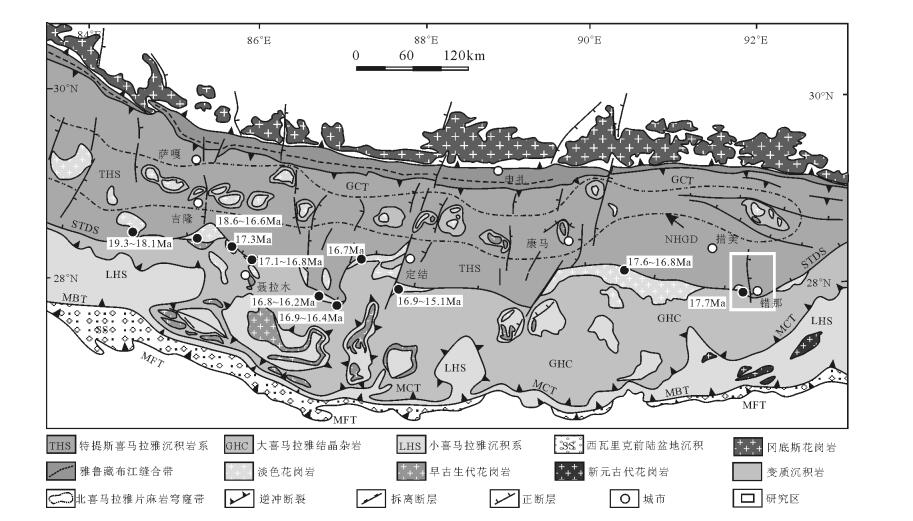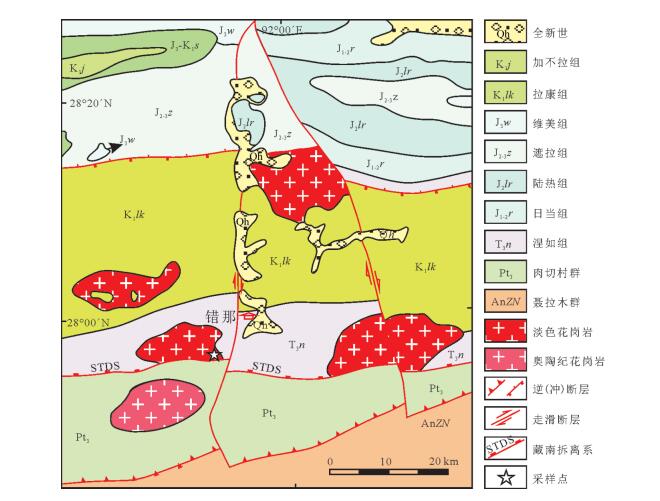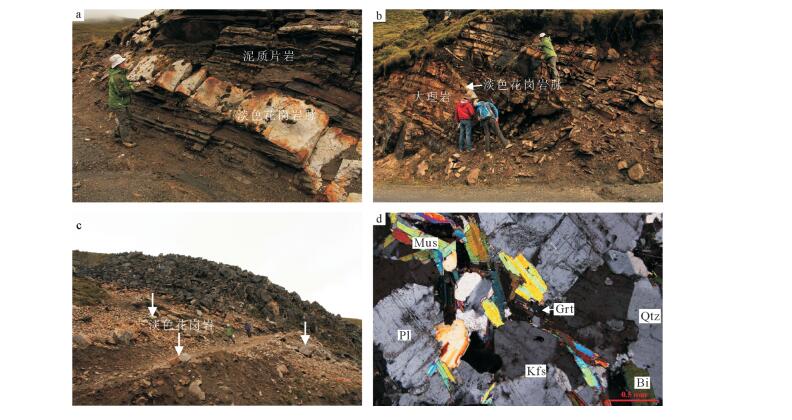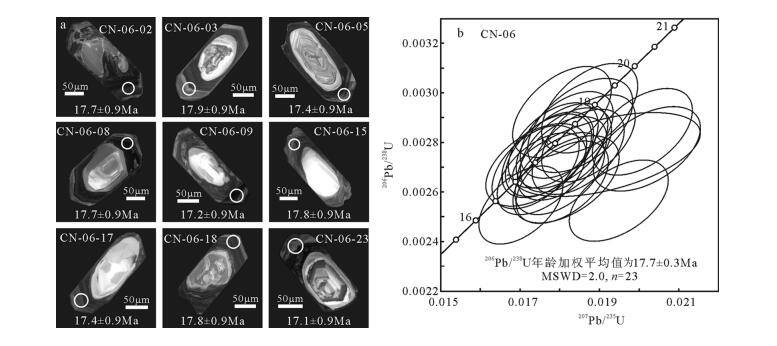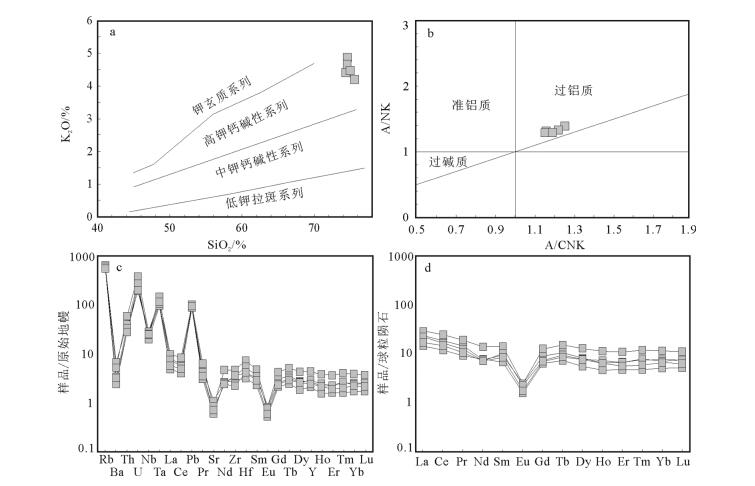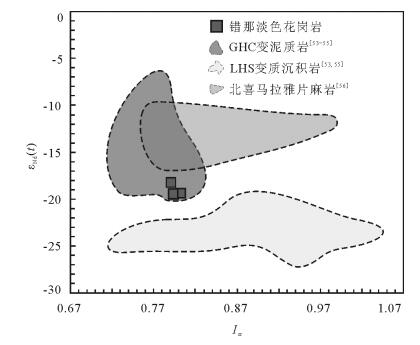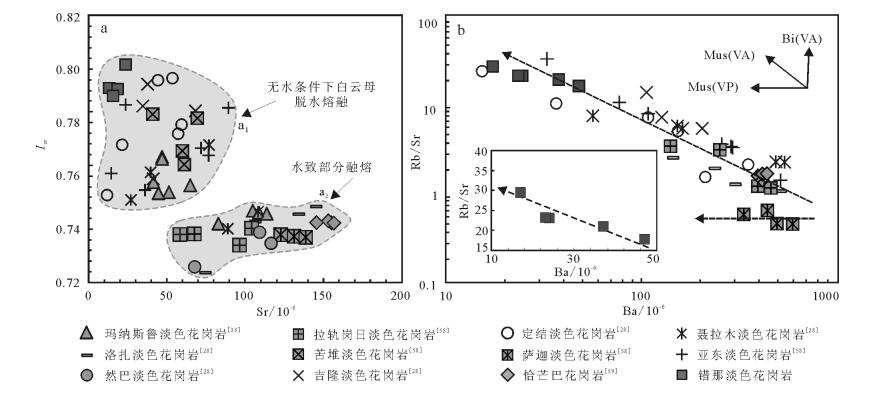Age and geochemistry of the Cuona leucogranite in southern Tibet and its geological implications
-
摘要:
藏南错那淡色花岗岩位于喜马拉雅造山带的东部。对其进行LA-MC-ICP-MS锆石U-Pb定年, 结果显示, 结晶年龄为17.7±0.3Ma, 代表中新世的地壳深熔作用。淡色花岗岩样品具有高的SiO2(74.46%~75.57%)、Al2O3(14.07%~14.64%)和K2O(4.19%~4.85%)含量, 高的K2O/Na2O值(1.09~1.31)和A/CNK值(1.15~1.25), 富集Rb、Th和U, 亏损Ba、Nb、Sr、Zr等元素, 显示高的Rb/Sr值(17.75~29.50)和强烈的负Eu异常(δEu=0.18~0.26), 属于壳源成因的高钾钙碱性过铝质S型花岗岩。样品具有高的Isr值(0.78982~0.79276)和低的εNd(t)值(-19.5~-18.2), 可与大喜马拉雅结晶杂岩(GHC)中的变泥质岩对比, 暗示其来自变泥质岩的部分熔融。样品的Isr值较高, 而Sr浓度较低, 且随着Ba浓度的增加, Rb/Sr值逐渐降低, 表明淡色花岗岩是无水条件下白云母部分熔融的产物, 部分熔融可能与藏南拆离系(STDS)伸展拆离导致的构造减压有关。错那淡色花岗岩的形成反映了地壳伸展减薄背景下, 构造减压导致的中下地壳中含水矿物脱水熔融, 并沿STDS上升侵位的动力学过程。
Abstract:The Cuona leucogranite pluton is situated in the east of Himalayan orogen. LA-MC-ICP-MS zircon U-Pb dating re-veals that leucogranites were crystallized at 17.7±0.3Ma, representing the Miocene crustal anataxis. Geochemical studies show that the samples are characterized by high SiO2(74.46%~75.57%), Al2O3(14.07%~14.64%), K2O(4.19%~4.85%), K2O/Na2O ratios(1.09~1.31) and A/CNK values(1.15~1.25), enrichment of Rb, Th, U and depletion of Ba, Nb, Zr, Sr, and high ratios of Rb/Sr(17.75~29.50) with strong negative Eu anomalies(δEu=0.18~0.26). These features suggest that they are crust-derived high potassium calcalkaline and peraluminous S-type granite. The relatively high Isr(0.78982~0.79276) and low εNd(t)(-19.5~-18.2) are well comparable with data of the metapelite from Greater Himalayan Crystalline complex(GHC), indicating that the leucogranites were generated from their partial melting. The features of high Isr and low Sr concentration as well as the decreasing Rb/Sr values with increasing Ba concentration demonstrate that the Cuona leucogranites were derived from muscovite dehydration melting under the water-absent condition, possibly triggered by structural decompression responding to the activity of South Tibetan Detachment system(STDS). It is held that the Cuona leucogranites reflect dynamics of structural decompression, dehydration melting and emplacement of the melt along STDS under the background of crustal extension and thinning.
-
Keywords:
- Cuona leucogranite /
- LA-MC-ICP-MS /
- zircon U-Pb dating /
- Sr-Nd isotopes /
- formation mechanism /
- southern Tibet
-
云南腾冲境内的火山群东西宽50km,南北长90km,区内共有68座具较明显山体的火山(图 1)。其中火山机构保存完整(有火山口、火山锥)的有25座,火山锥火山口不明显的有18座,其余25座火山机构遭到严重破坏,但仍见火山山体[1]。除固东北部几座外,其余全在本次区域重力调查区内。火山区的热泉、温泉、地热资源如何分布,火山有没有可能再次喷发而造成灾害,这些问题因扰着众多研究者,因此有必要对腾冲火山区与重力场的关系进行分析,并对火山的喷发机制进行探索。
笔者以腾冲地区1:20万区域重力调查资料为主,结合其他物探方法(航空磁测、地震等)、地质资料等综合分析了腾冲地区的火山机构、喷发机制。
1. 地质特征
腾冲火山区火山口主要沿马站—腾冲一线呈南北向线状展布(图 1),在芒棒—五合一带也出现了火山口。伴随火山口出现的是大面积的火山岩,从新近系芒棒组上部的玄武岩,到第四系更新统、全新统的玄武岩、安山玄武岩、安山岩、安山英安岩、英安岩。这些火山岩全具有磁性(表 1),密度为2.12×103~2.57×103g/cm3(表 2),由于这些火山岩普遍具有气孔,所以密度均较低。
表 1 腾冲火山区主要岩(矿)石标本岩性磁参数测定统计成果Table 1. Statistical results of magnetic parameters of main rocks (ores) in Tengchong volcanic field地层代号 岩性 磁化率(K)/10-6×4π-SI 剩磁/(10-3A.m-1) 磁性 含量范围 平均值 含量范围 平均值 Q41b 玄武岩 510.24~2498.31 1529.62 2731.54~13409.25 7798.28 强磁性 Q42b 安山岩 520.13~1745.71 967.04 1395.68~5796.15 3693.69 磁性 Q32b 安山玄武岩 347.33~2670.33 1148.7 609.19~6218.05 3441.18 磁性 玄武岩 1257.78~1526.77 1392.27 961.19~1184.04 1072.61 磁性 Q3lb 玄武岩 256.61~2394.81 1034.48 548.61~33955 1859.84 磁性 Q1b 英安岩 595.01~3362.25 1199.82 583.07~4643.63 1904.65 磁性 N2m2 玄武岩 386.00~3003.10 1421.64 1035.62~8413.83 2620.06 磁性 粒玄岩 1246.27~2553.19 2039.6 574.29~11463.56 5755.39 磁性 ∈? 混合岩化片麻岩 50.11~716.45 195.45 30.07~337.11 87.99 弱磁 Pz1gl2 片麻岩 68.51~2668.79 573.71 34.15~2644 286.48 弱磁 Pz1g 片麻岩(混合岩化) 12.02~119.55 50.64 22.76~70.21 43.76 微磁性 表 2 腾冲地区主要地层密度参数Table 2. Rock density parameters of main strata in Tengchong area地层 代号 标本数/块 平均密度值/(g·cm-3) 第四系 Qhal 75 1.69 Qha 30 2.12 Qhαβ 60 2.26 Qhpl 25 1.84 Qpβ 30 2.48 Qpal 5 1.94 Qpα 20 2.5 Qpξ 25 2.57 新近系 N2m 115 1.88 二叠系 P2dd 70 2.65 Pk 35 2.53 P1b 15 2.5 泥盆系 D1g 60 2.62 梅家山岩群 Pt3eλ 20 2.65 高黎贡山岩群 Pt1GL 165 2.61 马站-腾冲及龙川江新生界之间主要为燕山期花岗岩。龙川江的东侧主要为元古宇高黎贡山群深变质岩,但主要岩性为片麻状花岗岩。花岗岩密度为2.61×103g/cm3(表 2),磁性为弱磁性(表 1)。
2. 重力场特征及解释
剩余重力异常(图 2-a)清楚地显示,火山区中部为一条南北向的重力正异常,东西宽约10km,南北从蒲川-曲石长约60km,剩余异常幅值2×10-5m/s2以上,异常中心位于打苴乡-勐连乡的东侧,最高值达到8×10-5m/s2。西侧北段为马站-腾冲重力负异常,负异常幅值较大,异常东侧还有一正异常,负异常两侧等值线密集,梯度变化剧烈,异常中心位于棕包园,最小值达到-13×10-5m/s2。中段清水一带,负异常较平缓,甚至出现了正异常。新华乡处似被正异常割断,然后是负异常。总体上,从马站-腾冲-蚂蝗塘仍为较连续的负异常。东侧皆为负异常,北段与高黎贡山重力低合为一体,南段芒棒-团田形成自行封闭的负异常,异常中心位于五合-龙江,负异常幅值达-9×10-5m/s2。东侧负异常总体与高黎贡山负异常合为一体,同时在高黎贡山负异常的背景上形成几处圈闭的负异常。曲石-蒲川正异常最大值与两侧负异常最小值差值达21×10-5m/s2。
通过该区的水平总梯度模重力异常图(图 2-b),可以清晰地反映出该区的梯度变化情况,曲石-蒲川重力高东西两侧皆形成了剧烈的梯级带,西侧主要出现在北段,梯度变化普遍高于3×10-5m/(s2·km-1),最高值达到5×10-5m/(s2·km-1)。东侧从南到北都出现了梯度异常,只是北段变化稍弱,但变化值高于1.5×10-5 m/(s2· km-1),南段变化较大,普遍高于2×10-5m/(s2· km-1),最高值达到4.75×10-5m/(s2· km-1)。在马站-腾冲还有一梯级带,变化值普遍高于2×10-5m/(s2· km-1),最高值达到4.5×10-5m/(s2·km-1),但梯级带延伸不长。
重力低所对应的地层是新生界火山岩及松散沉积,据物性统计,新生界密度较低,因此,重力低主要由新生界引起。重力高对应的地层主要为燕山期花岗岩,花岗岩本身密度较低,虽然相对于两侧的新生界密度较高,但两侧的新生界厚度并不大,且相对于龙川江东侧的元古宇没有密度差,但异常性质相反,曲石-蒲川为重力高,高黎贡山为重力低,说明曲石-蒲川重力高的下伏还应存在密度更高的物质,推测可能存在基性-超基性岩。
3. 航磁异常特征及解释
腾冲火山区航磁ΔT(图 3-a)主要为正磁异常背景,负异常主要出现在东北,区内形成规模较大的磁异常,马站-清水磁异常形如掌状,呈北北东向展布,幅值达到200nT,清水一带,异常向东南扭转呈南北向,并向南延伸至新华。另一异常呈南北向长条带状展布,从上营北一直延伸到蒲川,幅值也达到了200nT。打苴乡—蒲川有一狭长低值带,似将两异常分开。化极后,异常向北移动,腾冲磁异常移至马站—腾冲,形如脚掌,北宽南窄。东边的磁异常仍为长条带状,只是向北移动了。上延10km后(图 3-b),两异常合为一体。
磁异常对应的地层主要为新生界火山岩,据物性统计,这些火山岩均具有磁性,无疑磁异常是由新生代喷出地表的火山岩引起的。但曲石-蒲川虽呈一条狭长的低值带,上延后两侧的异常合为一体,况且上营-团田磁异常与沿龙川江出露的芒棒组并不对应,而是偏向西,且芒棒并不全是玄武岩。唯一的解释是曲石-蒲川的花岗岩下伏存在磁性物质,推测可能是基性-超基性岩。
4. 人工地震结果
1999年云南省地震局在腾冲地区实施了“腾深99人工地震测深工程”,纵测线南起潞西县中山乡,经潞西、龙陵、腾冲县团田、腾冲县城、固东、明光等地,至自治乡,全长178km。测线处北向南穿过大团山、小团山、大黑山、小黑山、大空山、小空山等多座火山。第一条横测线西起盈江的新城,经梁河、囊宋,向东经上营,至怒江边上的道街,全长约85km。第二条横测线从西端的猴桥,经古永、三联、曲石,至大坝,全长约50km(图 4)。以此为基础,云南省地震局进行了三维速度结构反演,图 4为三维速度截面图。资料显示在深度4~10km,位于团田与腾冲之间、热海东侧有一低速体,推测为岩浆囊[1-2]。
![]() 图 4 地震剖面及速度结构图(据参考文献[2]修改)六角星为爆破点,三角星为接收点,叉为速度模型节点Figure 4. Seismic profile and velocity structure
图 4 地震剖面及速度结构图(据参考文献[2]修改)六角星为爆破点,三角星为接收点,叉为速度模型节点Figure 4. Seismic profile and velocity structure5. 综合推断解释
在清水-芒棒图横切一条重磁剖面进行反演,从反演结果(图 5)可知,重力低同时具有高磁化强度的异常由第四系火山岩引起,因为第四系火山岩磁化率较高,而且该区火山岩气孔较发育,所以密度较低。高密度同时具有高磁化强度,经反演,由下伏基性岩引起。因该剖面与地震新城—道街剖面基本重合,剖面显示热海东侧下伏4~10km有一低速低,与重力高及磁异常的位置基本一致,所以高密度、高磁化强度的物质同时还具有低速的特性,那么满足这3个物理性质的物质只有基性岩浆。仔细比对地震新城-道街剖面及中山-自治剖面,低速体的位置与重力高磁异常基本一致。中山—自治地震剖面腾冲以北没有低速异常是因为腾冲以北剖面没有在重力高里面,而腾冲—团田段刚好穿过重力高,打破了以前关于岩浆囊是在火山热海下面的认识。从新城-自治剖面看,结果也一样,低速体并不在热海下方,而是在东侧,与重力高的位置重合。由此推测,在曲石-蒲川的重力高下面存在基性岩浆。整个火山机构包括马曲石-蒲川下覆的基性岩浆和通过两侧龙川江断裂与腾冲-盈江断裂喷出地表的火山岩。幔源挥发分释放强度空间分布(图 6)与相对地热梯度平面分布(图 7)反映的位置也与重力高基本一致。
![]() 图 7 腾冲火山区相对地热梯度平面分布[4](地热梯度单位为℃)Figure 7. Relative geothermal gradient plane distribution in Tengchong volcanic field
图 7 腾冲火山区相对地热梯度平面分布[4](地热梯度单位为℃)Figure 7. Relative geothermal gradient plane distribution in Tengchong volcanic field6. 结论
低密度的花岗岩上产生了重力高, 预示着下伏可能存在高密度的物质, 高磁指示下伏的物质应该是基性的, 而低速的特征说明该物质是塑性或流体的。综合高密度、强磁性、低速的特征, 推断该物质为还未固结的基性岩浆。通过重力高的范围和位置, 以及幔源挥发分释放强度空间分布与相对地热梯度平面分布, 基本可以确定腾冲火山下伏岩浆房的位置在曲石-蒲川重力高的下面。通过人工地震确定岩浆房的深度为4~10km, 有再次喷发的可能, 所以要做好监测与防范。通过重力梯级带可确定腾冲火山区下伏岩浆主要通过龙川江断裂与腾冲-盈江断裂喷出地表, 因此可通过区域重力划定的断裂来寻找地热资源加以利用。
致谢: 样品前处理得到北京大学地球与空间科学学院朱文萍工程师的帮助,LA-MC-ICPMS锆石U-Pb同位素和全岩Rb-Sr、Sm-Nd同位素测试得到天津地质矿产研究所耿建珍和崔玉荣工程师的指导和帮助,审稿人对论文进行了详细审阅并提出宝贵的修改意见,在此一并表示衷心的感谢。 -
图 1 喜马拉雅造山带中东段地质简图(据参考文献[35]修改)
GCT—大反冲断层;STDS—藏南拆离系;MCT—主中央逆冲断裂;MBT—主边界逆冲断裂;MFT—主前锋逆冲断裂;NHGD—北喜马拉雅片麻岩穹窿
Figure 1. Sketch geological map of the middle and east Himalayan orogen
图 5 藏南错那淡色花岗岩的SiO2-K2O (a)、A/CNK-A/NK分类图解(b)及原始地幔标准化蛛网图(c)和球粒陨石标准化稀土元素配分模式图(d) (原始地幔和球粒陨石数值据参考文献[41])
Figure 5. TAS diagram (a), A/CNK-A/NK diagram (b), primitive mantle-normalized trace element spider diagram (c) and chondrite-normalized REE patterns (d) of Cuona leucogranites, southern Tibet
表 1 藏南错那淡色花岗岩样品(CN-06)LA-MC-ICP-MS锆石U-Th-Pb同位素测试数据
Table 1 LA-MC-ICP-MS zircon U-Th-Pb isotopic data of the leucogranite sample CN-06 from Cuona, southern Tibet
分析点号 Pb Th U Th/U 同位素比值 表观年龄/Ma 10-6 207Pb/235U ±1σ 206Pb/238U ±1σ 208Pb/232Th ±1σ 207Pb/235U ±1σ 206Pb/238U ±1σ 208Pb/232Th ±1σ 01 2598 339 8357 0.04 0.0170 0.0009 0.00255 0.00013 0.00108 0.00006 17.1 0.9 16.4 0.8 21.9 1.3 02 2687 208 8481 0.02 0.0177 0.0009 0.00275 0.00014 0.00087 0.00010 17.8 0.9 17.7 0.9 17.6 2.0 03 2716 213 8475 0.03 0.0181 0.0010 0.00279 0.00014 0.00086 0.00009 18.2 0.9 17.9 0.9 17.5 1.9 04 2889 226 8970 0.03 0.0175 0.0009 0.00267 0.00013 0.00085 0.00007 17.7 0.9 17.2 0.9 17.3 1.3 05 2612 275 8418 0.03 0.0174 0.0009 0.00270 0.00014 0.00086 0.00007 17.5 0.9 17.4 0.9 17.5 1.4 06 2944 309 8375 0.04 0.0201 0.0010 0.00284 0.00014 0.00177 0.00011 20.2 1.0 18.3 0.9 35.7 2.3 07 2826 187 8499 0.02 0.0185 0.0011 0.00287 0.00015 0.00166 0.00027 18.6 1.1 18.5 1.0 33.6 5.4 08 2630 298 8395 0.04 0.0177 0.0009 0.00275 0.00014 0.00083 0.00006 17.9 0.9 17.7 0.9 16.7 1.1 09 2634 350 8344 0.04 0.0180 0.0009 0.00267 0.00014 0.00103 0.00007 18.1 0.9 17.2 0.9 20.9 1.3 10 2747 207 8481 0.02 0.0182 0.0010 0.00283 0.00014 0.00111 0.00010 18.3 1.0 18.2 0.9 22.4 2.0 11 3001 250 8433 0.03 0.0202 0.0011 0.00277 0.00014 0.00284 0.00022 20.3 1.1 17.9 0.9 57.3 4.5 12 2707 439 8254 0.05 0.0181 0.0010 0.00264 0.00014 0.00136 0.00010 18.2 1.0 17.0 0.9 27.4 2.1 13 2834 371 8321 0.04 0.0195 0.0010 0.00257 0.00013 0.00232 0.00015 19.6 1.0 16.5 0.9 46.8 2.9 14 2721 354 8336 0.04 0.0181 0.0009 0.00274 0.00014 0.00102 0.00007 18.2 0.9 17.6 0.9 20.7 1.4 15 2719 193 8496 0.02 0.0182 0.0009 0.00277 0.00014 0.00117 0.00012 18.3 0.9 17.8 0.9 23.7 2.4 16 3128 225 8456 0.03 0.0192 0.0019 0.00275 0.00014 0.00430 0.00048 19.3 1.9 17.7 0.9 86.7 9.6 17 2612 192 8501 0.02 0.0174 0.0010 0.00271 0.00014 0.00090 0.00025 17.5 1.0 17.4 0.9 18.3 5.0 18 2699 337 8354 0.04 0.0185 0.0010 0.00276 0.00014 0.00106 0.00008 18.6 1.0 17.8 0.9 21.4 1.6 19 2704 278 8412 0.03 0.0187 0.0010 0.00282 0.00014 0.00112 0.00009 18.8 1.0 18.1 0.9 22.7 1.7 20 2832 305 8379 0.04 0.0188 0.0010 0.00294 0.00015 0.00100 0.00009 18.9 1.0 18.9 1.0 20.2 1.8 21 3020 198 8483 0.02 0.0181 0.0010 0.00292 0.00015 0.00300 0.00024 18.2 1.0 18.8 1.0 60.6 4.8 22 2760 400 8290 0.05 0.0178 0.0009 0.00279 0.00014 0.00126 0.00011 18.0 0.9 18.0 0.9 25.4 2.3 23 2677 509 8186 0.06 0.0182 0.0011 0.00265 0.00014 0.00158 0.00022 18.3 1.1 17.1 0.9 32.0 4.4 表 2 藏南错那淡色花岗岩全岩主量、微量和稀土元素测试数据
Table 2 Whole-rock major, trace and rare earth element analyses of the Cuona leucogranites in southern Tibet
样品号 CN-01 CN-02 CN-03 CN-04 CN-05 SiO2 74.59 74.58 74.46 74.87 75.57 Al2O3 14.48 14.64 14.60 14.31 14.07 Fe2O3 0.70 0.83 0.90 0.77 0.69 MgO 0.08 0.09 0.10 0.07 0.08 CaO 0.51 0.53 0.59 0.64 0.67 Na2O 3.69 3.64 3.51 3.90 3.84 K2O 4.85 4.68 4.41 4.48 4.19 TiO2 0.02 0.03 0.04 0.03 0.03 P2O5 0.20 0.19 0.18 0.18 0.15 MnOz 0.04 0.04 0.06 0.05 0.04 烧失量 0.8 0.7 1.1 0.7 0.7 合计 99.16 99.25 98.85 99.30 99.33 A/NK 1.28 1.32 1.38 1.27 1.30 A/CNK 1.18 1.22 1.25 1.15 1.16 Na2O+K2O 8.54 8.32 7.92 8.38 8.03 K2O/Na2O 1.31 1.29 1.26 1.15 1.09 CaO/Na2O 0.14 0.15 0.17 0.16 0.17 Be 7 12 10 16 14 Sc 3 3 4 3 3 Co 0.4 0.2 0.4 0.5 1.1 Ni 0.1 0.1 0.3 0.2 0.2 Zn 5 9 13 11 9 Ga 16.9 18.5 20.8 18.9 19.5 Rb 377.6 413.5 381.7 353.8 353.0 Sr 12.8 23.3 18.2 15.3 15.2 Y 9.7 12.8 20.1 13.3 11.2 Zr 32.6 39.9 52.9 41.0 25.2 Nb 14.2 17.7 20.5 18.3 18.0 Cs 25.3 30.9 31.2 25.7 23.7 Ba 17 47 37 24 23 La 3.4 5.5 6.8 5.2 4.0 Ce 7.2 11.2 14.9 10.0 8.9 Pr 0.86 1.37 1.79 1.17 0.99 Nd 3.6 3.5 6.4 3.3 3.3 Sm 1.03 1.43 2.15 1.55 1.28 Eu 0.09 0.14 0.14 0.13 0.10 Gd 1.29 1.83 2.57 1.49 1.42 Tb 0.27 0.39 0.56 0.35 0.32 Dy 1.39 2.07 3.24 1.95 1.93 Ho 0.26 0.36 0.63 0.41 0.36 Er 0.78 1.11 1.78 1.09 0.92 Tm 0.12 0.19 0.30 0.20 0.15 Yb 0.86 1.28 1.94 1.18 1.11 Lu 0.13 0.19 0.28 0.19 0.16 Hf 1.0 1.3 2.3 1.7 1.3 Ta 4.0 4.4 5.4 6.1 4.8 Pb 6.3 6.7 7.2 6.3 6.7 Th 2.4 3.4 5.0 2.9 2.4 U 5.4 5.7 8.1 4.1 4.2 Sn 14 17 20 14 12 Rb/Sr 29.50 17.75 20.97 23.12 23.22 LREE 16.18 23.14 32.18 21.35 18.57 HREE 5.10 7.42 11.30 6.86 6.37 TREE 21.28 30.56 43.48 28.21 24.94 (La/Sm)w 2.13 2.49 2.04 2.17 2.02 (Gd/Yb)N 1.24 1.18 1.10 1.04 1.06 (La/Yb)N 2.84 3.08 2.52 3.16 2.59 δEu 0.24 0.26 0.18 0.26 0.23 注:主量元素含量单位为%,微量和稀土元素含量单位为10-6;A/NK=摩尔Al2O3/ (Na2O+K2O),A/ CNK=摩尔Al2O3/ (CaO+Na2O+K2O);δEu=2EuN/ (SmN+GdN),其中N为球粒陨石标准化值[41] 表 3 藏南错那淡色花岗岩全岩Rb-Sr和Sm-Nd同位素测试数据
Table 3 Whole-rock Rb-Sr and Sm-Nd isotopic compositions of the Cuona leucogranites in southern Tibet
样品号 t/Ma Rb/10-6 Sr/10-6 87Rb/86Sr 87Sr/86Sr 2σ Isr Sm/10-6 Nd/10-6 147Sm/144Nd 143Nd/144Nd 2σm TDM2/Ma εNd(t) CN-01 18.0 377.6 12.8 83.3240 0.81406 0.00020 0.79276 1.03 3.60 0.181524 0.511636 0.000004 2372 -19.5 CN-02 18.0 413.5 23.3 50.1266 0.81431 0.00006 0.80150 1.43 3.50 0.259220 0.511652 0.000004 2469 -19.4 CN-04 18.0 353.8 15.3 65.3153 0.80910 0.00001 0.79241 1.55 3.30 0.298001 0.511654 0.000004 2452 -19.4 CN-05 18.0 353.0 15.2 65.5963 0.80659 0.00001 0.78982 1.28 3.30 0.246091 0.511709 0.000006 2390 -18.2 注:87Rb/86Sr和147Sm/144Nd通过ICP-MS测试的微量元素Rb、Sr、Sm和Nd计算所得,计算公式为87Rb/86Sr=Rb/Sr×2.981,147Sm/144Nd=Sm/Nd×[0.531497+0.142521×(143Nd/144Nd)s]。ISr=(87Sr/86Sr)s+87Rb/86Sr(eλt–1),143Nd/144Nd(t)=(143Nd/144Nd)s+147Sm/144Nd (eλt-1);εNd(t)=[ (143Nd/144Nd)s/ (143Nd/144Nd)CHUR-1]×104。(143Nd/144Nd)CHUR=0.512638,(147Sm/144Nd)CHUR=0.1967,(143Nd/144Nd)DM=0.51315,(147Sm/144Nd)DM=0.2137;λRb=1.42×10-12/年[42],λSm=6.54×10-12/年[43];二阶段模式年龄TDM2的计算见参考文献[41] -
吴福元, 刘志超, 刘小驰, 等.喜马拉雅淡色花岗岩[J].岩石学报, 2015, 31(1):1-36. Searle M P, Godin L.The South Tibetan Detachment system and the Manaslu leucogranite:a structural re-interpretation and restoration of the Annapurna Manaslu Himalaya, Nepal[J]. Journal of Geology, 2003, 111(5):505-523. Searle M P, Godin L.The South Tibetan Detachment system and the Manaslu leucogranite:a structural re-interpretation and restoration of the Annapurna Manaslu Himalaya, Nepal[J]. Journal of Geology, 2003, 111(5):505-523.
Annen C, Scaillet B, Sparks R S J. Thermal constraints on the em-placement rate of a large intrusive complex:The Manaslu leucogranite, Nepal Himalaya[J]. Journal of Petrology, 2006, 47(1):71-95. Annen C, Scaillet B, Sparks R S J. Thermal constraints on the em-placement rate of a large intrusive complex:The Manaslu leucogranite, Nepal Himalaya[J]. Journal of Petrology, 2006, 47(1):71-95.
Cottle J M, Jessup M J, Newell D L, et al. Structural insights into the early stages of exhumation along an orogen-scale detachment:The South Tibetan Detachment system, Dzakaa Chu section, eastern Himalaya[J]. Journal of Structural Geology, 2007, 29(11):1781-1797. Cottle J M, Jessup M J, Newell D L, et al. Structural insights into the early stages of exhumation along an orogen-scale detachment:The South Tibetan Detachment system, Dzakaa Chu section, eastern Himalaya[J]. Journal of Structural Geology, 2007, 29(11):1781-1797.
Yang X Y, Zhang J J, Qi G W, et al. Structure and deformation around the Gyirong basin, north Himalaya, and onset of the south Tibetan detachment[J]. Science in China(Series D), 2009, 52(8):1046-1058. Yang X Y, Zhang J J, Qi G W, et al. Structure and deformation around the Gyirong basin, north Himalaya, and onset of the south Tibetan detachment[J]. Science in China(Series D), 2009, 52(8):1046-1058.
Larson K P, Godin L, Davis J D, et al. Out-of-sequence deformation and expansion of the Himalayan orogenic wedge:Insight from the Changgo culmination, south central Tibet[J]. Tectonics, 2010, 29(4):1-30. Larson K P, Godin L, Davis J D, et al. Out-of-sequence deformation and expansion of the Himalayan orogenic wedge:Insight from the Changgo culmination, south central Tibet[J]. Tectonics, 2010, 29(4):1-30.
Leloup P H, Maheo G, Arnaud N, et al. The South Tibet detach-ment shear zone in the Dinggye area:Time constraints on extrusion models of the Himalayas[J]. Earth and Planetary Science Letters, 2010, 292(1/2):1-16. Leloup P H, Maheo G, Arnaud N, et al. The South Tibet detach-ment shear zone in the Dinggye area:Time constraints on extrusion models of the Himalayas[J]. Earth and Planetary Science Letters, 2010, 292(1/2):1-16.
Chambers J, Parrish R R, Argles T, et al. A short-duration pulse of ductile normal shear on the outer South Tibetan detachment in Bhutan:Alternating channel flow and critical taper mechanics of the eastern Himalaya[J]. Tectonics, 2011, 30(2):TC2005. Doi: 10.1029/2010TC002784. Chambers J, Parrish R R, Argles T, et al. A short-duration pulse of ductile normal shear on the outer South Tibetan detachment in Bhutan:Alternating channel flow and critical taper mechanics of the eastern Himalaya[J]. Tectonics, 2011, 30(2):TC2005. Doi: 10.1029/2010TC002784.
Liu X B, Liu X H, Leloup P H, et al. Ductile deformation within Upper Himalaya Crystalline Sequence and geological implications, in Nyalam area, Southern Tibet[J]. Chinese Science Bulletin, 2012, 57(26):3469-3481. Liu X B, Liu X H, Leloup P H, et al. Ductile deformation within Upper Himalaya Crystalline Sequence and geological implications, in Nyalam area, Southern Tibet[J]. Chinese Science Bulletin, 2012, 57(26):3469-3481.
Mitsuishi M, Simon R W, Aoya M, et al. E-W extension at 19 Ma in the Kung Co area, S.Tibet:Evidence for contemporaneous E-W and N-S extension in the Himalayan orogen[J]. Earth and Planetary Science Letters, 2012, 325/326:10-20. Mitsuishi M, Simon R W, Aoya M, et al. E-W extension at 19 Ma in the Kung Co area, S.Tibet:Evidence for contemporaneous E-W and N-S extension in the Himalayan orogen[J]. Earth and Planetary Science Letters, 2012, 325/326:10-20.
Yan D P, Zhou M F, Robinson P T, et al. Constraining the midcrustal channel flow beneath the Tibetan Plateau:Data from the Nielaxiongbo gneiss dome, SE Tibet[J]. International Geology Re-view, 2012, 54(6):615-632. Yan D P, Zhou M F, Robinson P T, et al. Constraining the midcrustal channel flow beneath the Tibetan Plateau:Data from the Nielaxiongbo gneiss dome, SE Tibet[J]. International Geology Re-view, 2012, 54(6):615-632.
莫宣学, 赵志丹, 邓晋福, 等.印度-亚洲大陆主碰撞过程的火山作用响应[J].地学前缘, 2003, 10(3):135-148. Zhang J J, Santosh M, Wang X X, et al. Tectonics of the northern Himalaya since the India-Asia collision[J]. Gondwana Research, 2012, 21(4):939-960. Zhang J J, Santosh M, Wang X X, et al. Tectonics of the northern Himalaya since the India-Asia collision[J]. Gondwana Research, 2012, 21(4):939-960.
Wang X X, Zhang J J, Liu J, et al. Middle-Miocene transforma-tion of tectonic regime in the Himalayan orogen[J]. Chinese Science Bulletin, 2013, 58(1):108-117. Wang X X, Zhang J J, Liu J, et al. Middle-Miocene transforma-tion of tectonic regime in the Himalayan orogen[J]. Chinese Science Bulletin, 2013, 58(1):108-117.
Edwards M A, Harrison T M. When did the roof collapse? Late Miocene north-south extension in the high Himalaya revealed by Th-Pb monazite dating of the KhulaKangrigranite[J]. Geology, 1997, 25(6):543-546. Edwards M A, Harrison T M. When did the roof collapse? Late Miocene north-south extension in the high Himalaya revealed by Th-Pb monazite dating of the KhulaKangrigranite[J]. Geology, 1997, 25(6):543-546.
Coleman M E. U-Pb constraints on Oligocene-Miocene deforma-tion and anatexis within the Central Himalaya, Marsyandi valley, Nepal[J]. American Journal of Science, 1998, 298(7):553-571. Coleman M E. U-Pb constraints on Oligocene-Miocene deforma-tion and anatexis within the Central Himalaya, Marsyandi valley, Nepal[J]. American Journal of Science, 1998, 298(7):553-571.
Harrison T M, Grove M, Lovera O M, et al. A model for the ori-gin of Himalayan anatexis and inverted metamorphism[J]. Journal of Geophysical Research, 1998, 103(B11):27017-27032. Harrison T M, Grove M, Lovera O M, et al. A model for the ori-gin of Himalayan anatexis and inverted metamorphism[J]. Journal of Geophysical Research, 1998, 103(B11):27017-27032.
Murphy M A, Harrison T M. Relationship between leucogranites and the Qomolangma detachment in the Rongbuk Valley, south Tibet[J]. Geology, 1999, 27(9):831-834. Murphy M A, Harrison T M. Relationship between leucogranites and the Qomolangma detachment in the Rongbuk Valley, south Tibet[J]. Geology, 1999, 27(9):831-834.
Schneider D, Edwards M, Kidd W S F, et al. Early Miocene anatex-is identified in the western syntaxis, Pakistan Himalaya[J]. Earth and Planetary Science Letters, 1999, 167(3/4):121-129. Schneider D, Edwards M, Kidd W S F, et al. Early Miocene anatex-is identified in the western syntaxis, Pakistan Himalaya[J]. Earth and Planetary Science Letters, 1999, 167(3/4):121-129.
Simpson R L, Parrish R R, Searle M P, et al. Two episodes of monazite crystallization during metamorphism and crustal melting in the Everest region of the Nepalese Himalaya[J]. Geology, 2000, 28(5):403-406. Simpson R L, Parrish R R, Searle M P, et al. Two episodes of monazite crystallization during metamorphism and crustal melting in the Everest region of the Nepalese Himalaya[J]. Geology, 2000, 28(5):403-406.
Kellett D A, Godin L. Pre-Miocene deformation of the Himalayan superstructure, Hidden valley, central Nepal[J]. Journal of the Geo-logical Society, 2009, 166(2):261-275. Kellett D A, Godin L. Pre-Miocene deformation of the Himalayan superstructure, Hidden valley, central Nepal[J]. Journal of the Geo-logical Society, 2009, 166(2):261-275.
Sachan H K, Kohn M J, Saxena A, et al. The Malari leucogranite, Garhwal Himalaya, northern India:Chemistry, age, and tectonic implications[J]. Geological Society of American Bulletin, 2010, 122(11/12):1865-1876. Sachan H K, Kohn M J, Saxena A, et al. The Malari leucogranite, Garhwal Himalaya, northern India:Chemistry, age, and tectonic implications[J]. Geological Society of American Bulletin, 2010, 122(11/12):1865-1876.
Daniel C, Vidal P, Fernandez A, et al. Isotopic study of the Manaslu granite(Himalaya, Nepal):Inferences of the age and source of Hi-malayan leucogranites[J]. Contributions to Mineralogy and Petrology, 1987, 96(1):78-92. Daniel C, Vidal P, Fernandez A, et al. Isotopic study of the Manaslu granite(Himalaya, Nepal):Inferences of the age and source of Hi-malayan leucogranites[J]. Contributions to Mineralogy and Petrology, 1987, 96(1):78-92.
Harris N, Inger S. Trace element modeling of pelite-derived gran-ites[J]. Contributions to Mineralogy and Petrology, 1992, 110(1):46-56. Harris N, Inger S. Trace element modeling of pelite-derived gran-ites[J]. Contributions to Mineralogy and Petrology, 1992, 110(1):46-56.
Harris N, Massey J. Decompression and anatexis of Himalayan metapelites[J]. Tectonics, 1994, 13(6):1537-1546. Harris N, Massey J. Decompression and anatexis of Himalayan metapelites[J]. Tectonics, 1994, 13(6):1537-1546.
Guillot S, Le Fort P. Geochemical constraints on the bimodal origin of High Himalayan leucogranites[J].Lithos, 1995, 35(3/4):221-234. Guillot S, Le Fort P. Geochemical constraints on the bimodal origin of High Himalayan leucogranites[J].Lithos, 1995, 35(3/4):221-234.
杨晓松, 金振民, Huenges E, 等.高喜马拉雅黑云斜长片麻岩脱水熔融实验:对青藏高原地壳深熔的启示[J].科学通报, 2001, 46(3):246-250. Guo Z F, Wilson M. The Himalayan leucogranites:Constraints on the nature of their crustal source region and geodynamic setting[J]. Gondwana Research, 2012, 22(2):360-376. Guo Z F, Wilson M. The Himalayan leucogranites:Constraints on the nature of their crustal source region and geodynamic setting[J]. Gondwana Research, 2012, 22(2):360-376.
Harris N, Ayres M, Massey J. Geochemistry of granitic melts pro-duced during the incongruent melting of muscovite:Implications for the extraction of Himalayan leucogranite magma[J]. Journal of Geophysical Research, 1995, 100(B8):15767-15777. Harris N, Ayres M, Massey J. Geochemistry of granitic melts pro-duced during the incongruent melting of muscovite:Implications for the extraction of Himalayan leucogranite magma[J]. Journal of Geophysical Research, 1995, 100(B8):15767-15777.
Harrison T M, Lovera O M, Grove M. New insights into the ori-gin of two contrasting Himalayan granite belts[J]. Geology, 1997, 25(10):899-902. Harrison T M, Lovera O M, Grove M. New insights into the ori-gin of two contrasting Himalayan granite belts[J]. Geology, 1997, 25(10):899-902.
Le Fort P, Cuney M, Deniel C, et al. Crustal generation of the Hi-malayan leucogranite[J]. Tectonophysics, 1987, 134(1/2/3):39-57. Le Fort P, Cuney M, Deniel C, et al. Crustal generation of the Hi-malayan leucogranite[J]. Tectonophysics, 1987, 134(1/2/3):39-57.
Davidson C, Grujic D E, Hollister L S, et al. Metamorphic reac-tions related to decompression and synkinematic intrusion of leuco-granite,High Himalayan Crystallines, Bhutan[J]. Journal of Meta-morphic Geology, 1997, 15(5):593-612. Davidson C, Grujic D E, Hollister L S, et al. Metamorphic reac-tions related to decompression and synkinematic intrusion of leuco-granite, High Himalayan Crystallines, Bhutan[J]. Journal of Meta-morphic Geology, 1997, 15(5):593-612.
Harrison T M, Grove M, McKeegan K D, et al. Origin and epi-sodic emplacement of the Manaslu intrusive complex, central Hi-malaya[J]. Journal of Petrology, 1999, 40(1):3-19. Harrison T M, Grove M, McKeegan K D, et al. Origin and epi-sodic emplacement of the Manaslu intrusive complex, central Hi-malaya[J]. Journal of Petrology, 1999, 40(1):3-19.
Nabelek P I, Liu M. Petrologic and thermal constraints on the ori-gin of leucogranites in collisional orogens[J]. Transactions of the Royal Society of Edinburgh:Earth Sciences, 2004, 95:73-85. Nabelek P I, Liu M. Petrologic and thermal constraints on the ori-gin of leucogranites in collisional orogens[J]. Transactions of the Royal Society of Edinburgh:Earth Sciences, 2004, 95:73-85.
张进江.北喜马拉雅及藏南伸展构造综述[J].地质通报, 2007, 26(6):639-649. Aikman A B, Harrison T M, Ding L. Evidence for early(>44Ma) Himalayan crustal thickening, Tethyan Himalaya, southern Tibet[J]. Earth 牡?瑤栠敐?瑡敮捥?瑡潲湹椠捓?敩癥潮汣略琠楌潥湴?潥晲?琬栠攲‰匰漸甬琠栲?吴椨戱支琲愩渺??椭洲愳氮愼祢慲嬾?崳??吠斋捓瑈漬渠椠換獟???パら???金??咷??セキ自??ㄠ?二??活动时代[J]. 大地构造与成矿学, 2015, 39(2):250-259. Aikman A B, Harrison T M, Ding L. Evidence for early( > 44Ma) Himalayan crustal thickening, Tethyan Himalaya, southern Tibet[J]. Earth and Planetary Science Letters, 2008, 274(1/2):14-23.
王晓先, 张进江, 闫淑玉, 等.藏南康马拆离断层的构造特征及其活动时代[J].大地构造与成矿学, 2015, 39(2):250-259. Ludwig K R. User's manual for Isoplot 3.00:A geochronological toolkit for Microsoft Excel[J]. Berkeley Geochronology Center Spe-cial Publication, 2003, 4:1-70. Liu Y S, Gao S, Hu Z C, et al. Continental and oceanic crust recy-cling-induced melt-peridotite interaction in the Trans-North China Orogen U-Pb dating, Hf isotopes and trace elements in zir-con from mantle xezoliths[J]. Journal of Petrology, 2009, 51(1/2):537-571.
Wu Y B, Zheng Y F. Genesis of zircon and its constraints on interpretation of U-Pb age[J]. Chinese Science Bulletin, 2004, 49(15):1554-1569. Ludwig K R. User's manual for Isoplot 3.00:A geochronological toolkit for Microsoft Excel[J]. Berkeley Geochronology Center Spe-cial Publication, 2003, 4:1-70.
Sun S S, McDonough W F. Chemical and isotopic systematics of oceanic basalts:Implications for mantle composition and process[J]. Geological Society of London Special Publication, 1989, 42(1):313-345. Wu Y B, Zheng Y F. Genesis of zircon and its constraints on interpretation of U-Pb age[J]. Chinese Science Bulletin, 2004, 49(15):1554-1569.
Steiger R H, Jäger E. Subcommission on geochronology:Convention on the use of decay constants in geochronology and cosmo-chronology[J]. Earth and Planetary Science Letters, 1977, 36(3):359-362. Sun S S, McDonough W F. Chemical and isotopic systematics of oceanic basalts:Implications for mantle composition and process[J]. Geological Society of London Special Publication, 1989, 42(1):313-345.
Lugmair G W, Harti K. Lunar initial 143Nd/144Nd:Differential evo-lution of the lunar crust and mantle[J]. Earth and Planetary Science Letters, 1978, 39(3):349-357. Steiger R H, Jäger E. Subcommission on geochronology:Convention on the use of decay constants in geochronology and cosmo-chronology[J]. Earth and Planetary Science Letters, 1977, 36(3):359-362.
Jahn B M, Wu F Y, Lo C H, et al. Crust-mantle interaction induced by deep subduction of the continental crust:Geochemical and Sr-Nd isotopic evidence from post-collisional mafic-ultramaf-ic intrusions of the northern Dabie complex, central China[J]. Chemistry Geology, 1999, 157(1/2):119-146. Lugmair G W, Harti K. Lunar initial 143Nd/144Nd:Differential evo-lution of the lunar crust and mantle[J]. Earth and Planetary Science Letters, 1978, 39(3):349-357.
Harrison T M, Mckeegan K D, LeFort P. Detection of inherited monazite in the Manaslu leukogranite by 208Pb/232Th ion micro-probe dating-crystallization age and tectonic implication[J]. Earth and Planetary Science Letters, 1995, 133(3/4):271-282. Jahn B M, Wu F Y, Lo C H, et al. Crust-mantle interaction induced by deep subduction of the continental crust:Geochemical and Sr-Nd isotopic evidence from post-collisional mafic-ultramaf-ic intrusions of the northern Dabie complex, central China[J]. Chemistry Geology, 1999, 157(1/2):119-146.
Searle M P, Parrish R R, Hodges K V. Shisha Pangma leucogran-ite, south Tibetan Himalaya:Field relations, geochemistry, age, ori-gin, and emplacement[J]. Journal of Geology, 1997, 105(5):295-317. Harrison T M, Mckeegan K D, LeFort P. Detection of inherited monazite in the Manaslu leukogranite by 208Pb/232Th ion micro-probe dating-crystallization age and tectonic implication[J]. Earth and Planetary Science Letters, 1995, 133(3/4):271-282.
Hodges K, Bowring S, Davidek K, et al. Evidence for rapid dis-placement on Himalayan normal faults and the importance of tectonic denudation in the evolution of mountain ranges[J]. Geology, 1998, 26(6):483-486. Searle M P, Parrish R R, Hodges K V. Shisha Pangma leucogran-ite, south Tibetan Himalaya:Field relations, geochemistry, age, ori-gin, and emplacement[J]. Journal of Geology, 1997, 105(5):295-317.
于俊杰, 曾令森, 刘静, 等.藏南定结地区早中新世淡色花岗岩的形成机制及其构造动力学意义[J]. 岩石学报, 2011, 27(7):1961-1972. Hodges K, Bowring S, Davidek K, et al. Evidence for rapid dis-placement on Himalayan normal faults and the importance of tectonic denudation in the evolution of mountain ranges[J]. Geology, 1998, 26(6):483-486.
于俊杰, 曾令森, 刘静, 等.藏南定结地区早中新世淡色花岗岩的形成机制及其构造动力学意义[J].岩石学报, 2011, 27(7):1961-1972. Kellett D A, Grujic D, Warren C, et al. Metamorphic history of a syn-convergent orogen-parallel detachment:The South Tibetan detachment system, Bhutan Himalaya[J]. Journal of Metamorphic Geology, 2010, 28(8):785-808. Imayama T, Takeshita T, Yi K, et al. Two-stage partial melting and contrasting cooling history within the Higher Himalayan Crys-talline Sequence in the far-eastern Nepal Himalaya[J]. Lithos, 2012, 134/135:1-22.
杨晓松, 金振民.西藏亚东淡色花岗岩Rb-Sr和Sm-Nd同位素研究:关于其年龄和源岩的证据[J]. 地质评论, 2001,47(3):294-300. Kellett D A, Grujic D, Warren C, et al. Metamorphic history of a syn-convergent orogen-parallel detachment:The South Tibetan detachment system, Bhutan Himalaya[J]. Journal of Metamorphic Geology, 2010, 28(8):785-808.
杨晓松, 金振民.西藏亚东淡色花岗岩Rb-Sr和Sm-Nd同位素研究:关于其年龄和源岩的证据[J].地质评论, 2001, 47(3):294-300. Ahmad T, Harris N, Bickle M, et al. Isotopic constraints on the structural relationships between the Lesser Himalayan Series and the High Himalayan Crystalline Series, Garhwal Himalaya[J]. Geological Society of America Bulletin, 2000,112(3):467-477. Knesel K M, Davidson J P. Insights into collisional magmatism from isotopic fingerprints of melting reactions[J]. Science, 2002, 296(5576):2206-2208.
Miller C, Thoni M, Frank W, et al. The early Paleozoic magmatic event in the Northwest Himalaya, India:Source, tectonic setting and age of emplacement[J]. Geological Magazine, 2001, 138(3):237-251. Ahmad T, Harris N, Bickle M, et al. Isotopic constraints on the structural relationships between the Lesser Himalayan Series and the High Himalayan Crystalline Series, Garhwal Himalaya[J]. Geological Society of America Bulletin, 2000, 112(3):467-477.
Richards A, Argles T, Harris N, et al. Himalayan architecture con-strained by isotopic tracers from clastic sediments[J]. Earth and Plan-etary Science Letters, 2005, 236(3/4):773-796. Miller C, Thoni M, Frank W, et al. The early Paleozoic magmatic event in the Northwest Himalaya, India:Source, tectonic setting and age of emplacement[J]. Geological Magazine, 2001, 138(3):237-251.
Gao L E, Zeng L S. Fluxed melting of metapelite and the forma-tion of Miocene high-CaO two-mica granites in the Malashan gneiss dome, southern Tibet[J]. Geochimicaet Cosmochimica Acta, 2014, 130:136-155. Richards A, Argles T, Harris N, et al. Himalayan architecture con-strained by isotopic tracers from clastic sediments[J]. Earth and Plan-etary Science Letters, 2005, 236(3/4):773-796.
Gehrels G E, DeCelles P G, Ojha T P, et al.Geological and U-Pb geochronological evidence for early Paleozoic tectonism in the Dadeldhura thrust sheet, far-west Nepal Himalaya[J]. Journal of Asian Earth Sciences, 2006, 25(4/5/6):385-408. Gao L E, Zeng L S. Fluxed melting of metapelite and the forma-tion of Miocene high-CaO two-mica granites in the Malashan gneiss dome, southern Tibet[J]. Geochimicaet Cosmochimica Acta, 2014, 130:136-155.
张宏飞, Harris N, Parrish R, 等. 北喜马拉雅淡色花岗岩地球化学:区域对比、岩石成因及构造意义[J]. 地球科学, 2005, 30(3):275-288. Gehrels G E, DeCelles P G, Ojha T P, et al.Geological and U-Pb geochronological evidence for early Paleozoic tectonism in the Dadeldhura thrust sheet, far-west Nepal Himalaya[J]. Journal of Asian Earth Sciences, 2006, 25(4/5/6):385-408.
张宏飞, Harris N, Parrish R, 等.北喜马拉雅淡色花岗岩地球化学:区域对比、岩石成因及构造意义[J].地球科学, 2005, 30(3):275-288. 王晓先, 张进江, 闫淑玉, 等.北喜马拉雅恰芒巴二云母花岗岩的年龄及形成机制[J].地质科学, 2015, 50(3):708-727. Zeng L S, Asimow P, Saleeby J B. Coupling of anatectic reactions and dissolution of accessory phases and the Sr and Nd isotope sys-tematics of anatectic melts from a metasedimentary source[J]. Geo-chimicaet Cosmochimica Acta, 2005, 69(4):3671-3682. PatiñoDouce A, Harris N. Experimental constraints on Himalayan anatexis[J]. Journal of Petrology, 1998, 39(4):689-710.
Zeng L S, Gao L E, Xie K J, et al. Mid-Eocene high Sr/Y granites in the Northern Himalayan Gneiss Domes:Melting thickening lower continental crust[J]. Earth and Planetary Science Letters, 2011, 303(3/4):251-266. Zeng L S, Asimow P, Saleeby J B. Coupling of anatectic reactions and dissolution of accessory phases and the Sr and Nd isotope sys-tematics of anatectic melts from a metasedimentary source[J]. Geo-chimicaet Cosmochimica Acta, 2005, 69(4):3671-3682.
Inger S, Harris N. Geochmical constraints on leucogranite magmatism in the Langtang Valley, Nepal Himalaya[J]. Journal of Petrolo-gy, 1993, 34(2):345-368. Zeng L S, Gao L E, Xie K J, et al. Mid-Eocene high Sr/Y granites in the Northern Himalayan Gneiss Domes:Melting thickening lower continental crust[J]. Earth and Planetary Science Letters, 2011, 303(3/4):251-266.
Liu Z C, Wu F Y, Ji W Q, et al. Petrogenesis of the Rambaleuco-granite in the Tethyan Himalayan and constraints on the channel flow model[J]. Lithos, 208/209:118-136. Inger S, Harris N. Geochmical constraints on leucogranite magmatism in the Langtang Valley, Nepal Himalaya[J]. Journal of Petrolo-gy, 1993, 34(2):345-368.
Lee J, Whitehouse M. Onset of mid-crustal extensional flow in southern Tibet:Evidence from U/Pb zircons age[J]. Geology, 2007, 35(1):45-48. Liu Z C, Wu F Y, Ji W Q, et al. Petrogenesis of the Rambaleuco-granite in the Tethyan Himalayan and constraints on the channel flow model[J]. Lithos, 208/209:118-136.
King J, Harris N, Argles T, et al. Contribution of crustal anatexis to the tectonic evolution of Indian crust beneath southern Tibet[J]. Geological Society of America Bulletin, 2011, 123(1/2):218-239. Lee J, Whitehouse M. Onset of mid-crustal extensional flow in southern Tibet:Evidence from U/Pb zircons age[J]. Geology, 2007, 35(1):45-48.
高利娥, 曾令森, 侯可军, 等. 藏南马拉山穹窿佩枯错复合淡色花岗岩体的多期深熔作用[J]. 科学通报, 2013, 58(27):2810-2822. King J, Harris N, Argles T, et al. Contribution of crustal anatexis to the tectonic evolution of Indian crust beneath southern Tibet[J]. Geological Society of America Bulletin, 2011, 123(1/2):218-239.
高利娥, 曾令森, 侯可军, 等.藏南马拉山穹窿佩枯错复合淡色花岗岩体的多期深熔作用[J].科学通报, 2013, 58(27):2810-2822. Cottle J M, Jessup M J, Newell D L, et al. Geochronology of granu-litized eclogite from the AmaDrime Massif:implications fo Catlos E J, Harrison T M, Manning C E, et al. Records of the evo-lution of the Himalayan orogen from in situ Th-Pb ion micro-probe dating of monazite:eastern Nepal and western Garhwal[J]. Journal of Asian Earth Science, 2002, 20(5):459-479.
Cottle J M, Jessup M J, Newell D L, et al. Geochronology of granu-litized eclogite from the AmaDrime Massif:implications for the tec-tonic evolution of the South Tibetan Himalaya[J]. Tectonics, 2009, 28(TC1002):1-25.




 下载:
下载:






